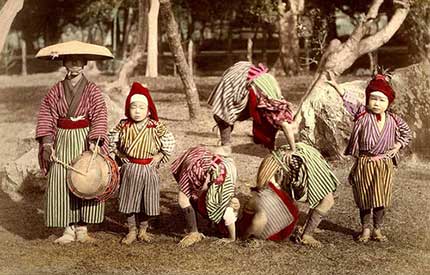Related Product: Management Gurus ebook
Gemba Kaizen training lets you be lazy. You switch between jobs faster than a ninja, you do less (re) work and you only do cool stuff because the boring jobs have gone (or are done by a machine). Oh, oh. Sounds suspiciously like Six Sigma or Total Quality Management or some other management clap-trap. Read on about Gemba Kaizen training and make up your own mind.
 Gemba kaizen training ninjas
Gemba kaizen training ninjasGemba is a Japanese word for “in the realplace” which when added to kaizen, means “continuous improvement in the workplace”. How does gemba kaizen differ from plain old quality circles? A possible explanation is that Professor Kaoru Ishikawa from Tokyo University’s “Quality Circles” brand was not acceptable to rival Kyoto university, so they came up with their own Gemba Kaizen brand. However both approaches grew from the same seed.
Nissan and Toyota car companies have a similar rivalry, and accordingly adopted different terms for the same thing. At Nissan, you would have “stockless production” but at Toyota, you would have “just-in-time” (JIT) production. Companies who had tried and failed to implement “quality circles” simply rebranded their quality improvement and cost cutting as “gemba kaizen” because they knew that the techniques were sound and they wanted a second chance to make it work.
Here is your Gemba Kaizen training 101, (or whatever you want to call it!)
Why bother with gemba kaizen?
It’s the old 80-20 rule. 80% of your costs are probably in only 20% of your processes. So by working to eliminate waste in your processes, you are striving towards leaner, meaner production.
Acronym number 1 – SMED (single minute exchange of die)
SMED, developed by management guru Shigeo Shingo is a collection of techniques to enable quick changeovers between products. Even my local chocolate shop gets this concept – they only have one chocolate tempering machine, so they make their white chocolate first, then the milk and finally the dark chocolate. To attempt any other production order would mean wasted time super-cleaning the machine to make sure the white chocolate remained white.
I got many management points for cutting an 8 hour changeover to just over 2 hours at a gin bottling plant, and one of the SMED techniques was to colour code the change parts and create a shadow board to hold both the change parts and tools to do the job. No more wandering off to the store-room and wandering back mid job when you’d remembered you’d forgotten to pick up the right sized spanner. All of this was done with the help of the production team, and unsurprisingly, it worked because they had been involved throughout.
The 5S’s of workplace (and bedroom) organisation
Before you think this is a Japanese lesson, you need to know about the 5s’s of workplace organisation.
These are:
Seiri – Sorting
Seiton – Straighten or set in order
Seiso – Systematic cleaning
Seiketsu – Standardising
Shitsuke – Sustain the discipline.
Imagine your teenage you’s bedroom with the 5S’s in place. You’d throw out all your too small or messed up clothes. You’d have your clothes on hangers, underwear in drawers and your CD’s in alphabetical order… in their boxes. You’d never have mouldy coffee mugs because everyday you’d tidy up. Your laundry would be done because you’d know which day mum did it and it would be sorted into lights and darks to make her life easier. And you’d get extra allowance because mum would be enjoying the easy life.
(Note to self: how can I get my two girls to adhere to the 5S’s…..?)
Autonomation and Jidoka – Red alert! Red alert!
 Jidoka warning lights
Jidoka warning lightsWhat would you rather do? Inspect a product after it’s been made, then fix the fault that occurred 1 hour ago and rework the imperfect articles. Or would you rather have mini checks at each key point in the process and stop producing when you find and fix the fault at its source?
Transport yourself to the Body Shop’s shampoo filling factory. You’ve noticed the shampoo labels are going on squint. As you’re checking regularly, you spot this before they were shrink-wrapped into their box. You go through your checklist of common reasons for squint labels and realise that the labels were slipping due to shampoo residue outside the bottle, left by a dirty filler machine. So, you stop the production line with a red light, and whilst helping clean the filler machine, your work-mate would be fixes the loose nozzle that caused the dribble. And production starts again – the red light turns green. With minimal time lost and scrap produced. That is simple “jidoka” or autonomation.
Okay, so we’ve covered some big concepts in our Gemba Kaizen training 101. So far we’ve found out its history, why it’s useful, what SMED is, what the 5S’s are, and what autonomation and jidoka are. Next, we learn about Kanban, root cause analysis, poke yoke mistake proofing, quality related cost reduction and flexible working groups (and sorry, no that’s not about a team of acrobats :o)
 Flexible Working Group
Flexible Working GroupKanban: Tickets please!
Kanban is a cunning way to manage your inventory. The word means “visible record” or “card” or “ticket” which gives you a clue as to how this works. First step is a customer “demanding” a product. This “pulls” an order through the supply chain – contrasting with product being made and then (hopefully) sold to a customer, “pushing” the product down the production line. A completed product being taken from the warehouse to give to the customer is a signal up the line to make a new one.
In the perfectly balanced world, products and their components would never go out of stock but this is generally not the reality. So, you keep enough component or product in a bin until you reach the trigger point, say 10 units, and more stock is ordered or made. The Kanban ticket would contain the specific details of what was needed for production to continue smoothly and passed to the relevant supplier. You would have calculated that the 10 units are just enough to keep you going until the big order arrived.
Of course, this relies on everything working smoothly, for example the re-order is not delayed, that all 10 units are usable and so on. Smoothing out these wrinkles in the production process and supply chain is what Gemba Kaizen is all about.
Root Cause Analysis: Why oh why oh why?
Often, it’s not obvious what is causing your problem. You put a lot of time and energy into fixing it, but yet it still happens. Here is a great example of root cause analysis thinking.
Poke Yoke mistake proofing: which way up?
Poke yoke is about stopping the mistake from ever happening in the first place – so no down line quality inspection is required. This can happen at the design stage, so that for example, a component is designed so that it can only be inserted the right way up. Or it can happen before components are assembled and defects are passed down the line. Back to the Oban Chocolate shop – they taste their raw chocolate before they process it (it’s a hard life!). Dumbfoundingly simple, but if you don’t test your raw ingredients, how can you guarantee that your hand made chocolate will taste fresh?
Quality Related cost reduction
In Six Sigma land, you have to calculate your “cost of poor quality”. In other words, how much time/resource could you save if you were to reduce or even eliminate the defects in your process.
For example, you know a certain type of customer complaint always takes more time than it should to resolve. After investigation, you discover that a subset of these customer complaints require another department to hunt out old customer data from a real filing cabinet, with real pieces of paper. Unsurprisingly, this department doesn’t like doing this task as they have 101 other, easier to complete, tasks to be getting on with. The problem is that the customer complaint makes up a disproportionate amount of calls into your call centre, as people are repeatedly calling back to check (non) progress of their complaint, PLUS the company loses money if the complaint goes stale.
After a bit of work, you persuade the department to fix their ways and deal with the task in a more timely manner. This is where your “cost of poor quality” figure kicks in. By fixing the process, you reduce the number of calls into the call centre and you avoid the time penalties, both of which have a real financial saving. Of course, the next step would be to stop the complaint arising in the first place, but that would be a whole new project!
Flexible working groups
Back to the acrobats… In order to achieve your gemba kaizen goals, you need people. As each problem you tackle will have different root causes, you need access to different people as you work through your problem “list”.
Not to be confused with people who are working on changing people’s working life to be more flexible, flexible working groups mean groups that are set up and dissolved based on the problem being tackled. So, this could mean you have different departments, levels of seniority and specialism all working together to solve the problem.
Flexible working groups will be as successful as the company culture allows. If John from accounts is too lofty to go to a meeting because it’s with Claire from the shop floor, gemba kaizen will not work. Creating a company culture of collaboration and shared objectives is the bedrock of gemba kaizen success.
 Successful Team
Successful TeamWhoah, I think it’s time to stop, that’s a lot of information! Gemba kaizen training might overlap greatly with Six Sigma or Total Quality Management but we’re not going to argue over who marketed their approach most successfully, as they have the same seed.
Download ‘Process Improvement Made Easy: Gemba Kaizen Training’ in pdf format
Images:
http://www.flickr.com/photos/23373709@N04/2807955756/
http://www.flickr.com/photos/_davo_/4329155091/
http://www.flickr.com/photos/24443965@N08/2801620513/
http://www.flickr.com/photos/michaelheiss/355852355/